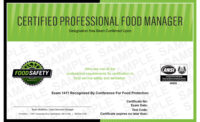When it comes to certifying your plants, where do you start? And which certification is best for your company, your products and your customers?
This was just one of many problem-solving discussions at the 2013 Food Safety Exchange, sponsored by Mettler-Toledo, Columbus, Ohio. The two-day educational forum took place June 11-12 at the Hilton Chicago/Indian Lakes Resort in Bloomingdale, Ill., and fused together manufacturers, processors, catering and foodservice companies, retailers, standards owners, auditors, consultants, trade organizations and other practitioners to learn more about today’s ever-changing food safety regulatory environment.
Refrigerated & Frozen Foods’ editor-in-chief Marina Mayer stopped in for a day to learn more about these food safety hot topics. Here’s a snapshot of what you missed:
The conference kicked off with keynote speaker Holly Mockus, director of quality systems for FONA International, Geneva, Ill., who provided an overview of the Global Food Safety Initiative (GFSI). Here, she discussed GFSI’s mission:
1. Create links with key organizations and regulators working with FDA and FSMA
2. Build confidence in third-party certification.
3. Build capacity.
4. Expand geographical consistencies and harmonize globally.
“We need to improve the integrity, consistency and reliability of how companies produce food,” Mockus says. “Once a company is GFSI-certified, it’s accepted everywhere.
Then, a series of workshops and educational sessions followed, including the British Retail Consortium (BRC) Workshop, led by John Kukoly, senior technical marketing consultant at BRC Global Standards, Buffalo, N.Y. Kukoly opened the session by asking, what constitutes an internal audit? Then he went on to discuss Codex, how obtaining evidence from a controlled measure helps to control the hazard of that specified level, such as shelf-life studies because the validation varies by product and human interaction (i.e., employee turnover, employee training, manual/human intervention). Kukoly broke down different sections of BRC coding to explain how managers and operators can validate certain actions (i.e., foot and floor traffic) and what’s needed to create an internal case study to ensure success.
“Verify only as often as you need to, especially with failure/success rate,” he adds.
In the Safe Quality Food (SQF) Workshop, LeAnn Chuboff, senior technical director for the Safe Quality Food Institute, Arlington, Va., talked about farm-to-fork certification, how to build a program for retailers and what different sections of the SQF code mean for each type of manufacturer. For example, Edition 7.1, the newest version of SQF, will be implemented July 1. With its introduction comes the SQF Advanced Practitioner course, a 1-day class with advanced implementation tools to advance food safety.
For example, “pure air, what is pure air? Think of compressed air, such as blowing air in a bag. This could be potential for food safety hazards or contamination,” she adds. “Conduct a risk assessment of air hand dryers. If employees don’t use it and they dry their hands on their pants, let’s say, then they can re-contaminate their hands. With the hand air dryers, where does that extra air go? If it bounces off of the floor and comes back up, then it can carry water, dirt, etc.”
Chuboff also spoke of auditor consistency, and how SQF is trying to get all committees (FDA, GFSI, SQF, etc.) on the same page to make sure they’re operating under a “calibrated,” uniform approach.
After a networking lunch came a second keynote from John Shapiro, partner in the Litigation Practice Group of Chicago-based Freeborn & Peters, LLC. Shapiro provided an overview of the Food Safety Modernization Act (FSMA), and how the FDA extended the implementation deadline to Sept. 16. Shapiro recommends that all companies acquire whistleblower protection, know your suppliers (15% of food is imported and food imports are growing at about 10% per year) and understand the disruptions in your supply chain.
“Be proactive and assess international operations and assess your supply chain partners,” Shapiro says. “The FDA doesn’t intend to design, implement, oversee and enforce alone. They need help in policing FSMA.”
Jacqueline Southee, a U.S. liaison for FSSC2200, called in from Washington, D.C. to provide an overview of the Food Safety Systems Certification, a 5-year-old, independently-managed, ISO-based, non-profit certification system that monitors FSMA. Global companies seek out a certification standard that uses existing international standards throughout the supply chain. FSSC22000 provides full alignment with GFSI in cooperation with food safety authorities.
“ISO standards are the backbone of how food safety works,” Southee says. “FSSC22000 has 5,000 certificates in 13 countries for companies such as Kraft, Danone, General Mills, Nestlé, Cargill, Unilever, McDonald’s and Walmart.”
Lastly, George Gansner, director of global marketing and business development for International Featured Standards (IFS), St. Louis, provided an overview of IFS, that it was developed by retailers but managed by the industry. It’s designed to match food safety and qualifications overseas with U.S. practices in areas such as hygiene, research and development, good manufacturing practices, traceability, GMO, allergens, packaging materials and customer requirements.
“There are 67 certification bodies, 1,000 auditors in 20 languages, 13,4000 certificates for manufacturers, 850 registered retailers and foodservice operators and 814 certificates for logistics and warehousing providers,” he adds.
Food manufacturers and retailers such as Kraft, McDonald’s, Tesco, Walmart, Target, Kroger, ConAgra, Aldi and Unilever currently accept IFS.
“We expect to have about 300-400 certification bodies by 2014,” Gansner says.
Day 2 of the forum consisted of case studies on best practices for inspection and observation systems and best practices for gaining and maintaining GFSI certification, as well as panel discusses on frequent audits and reactions to FDA’s proposed rule for preventive controls for human food.
Stay tuned for a more in-depth roundtable discussion with members from each certification body to stay up-to-date with today's ever-changing food safety rules, regulations and certifications.



